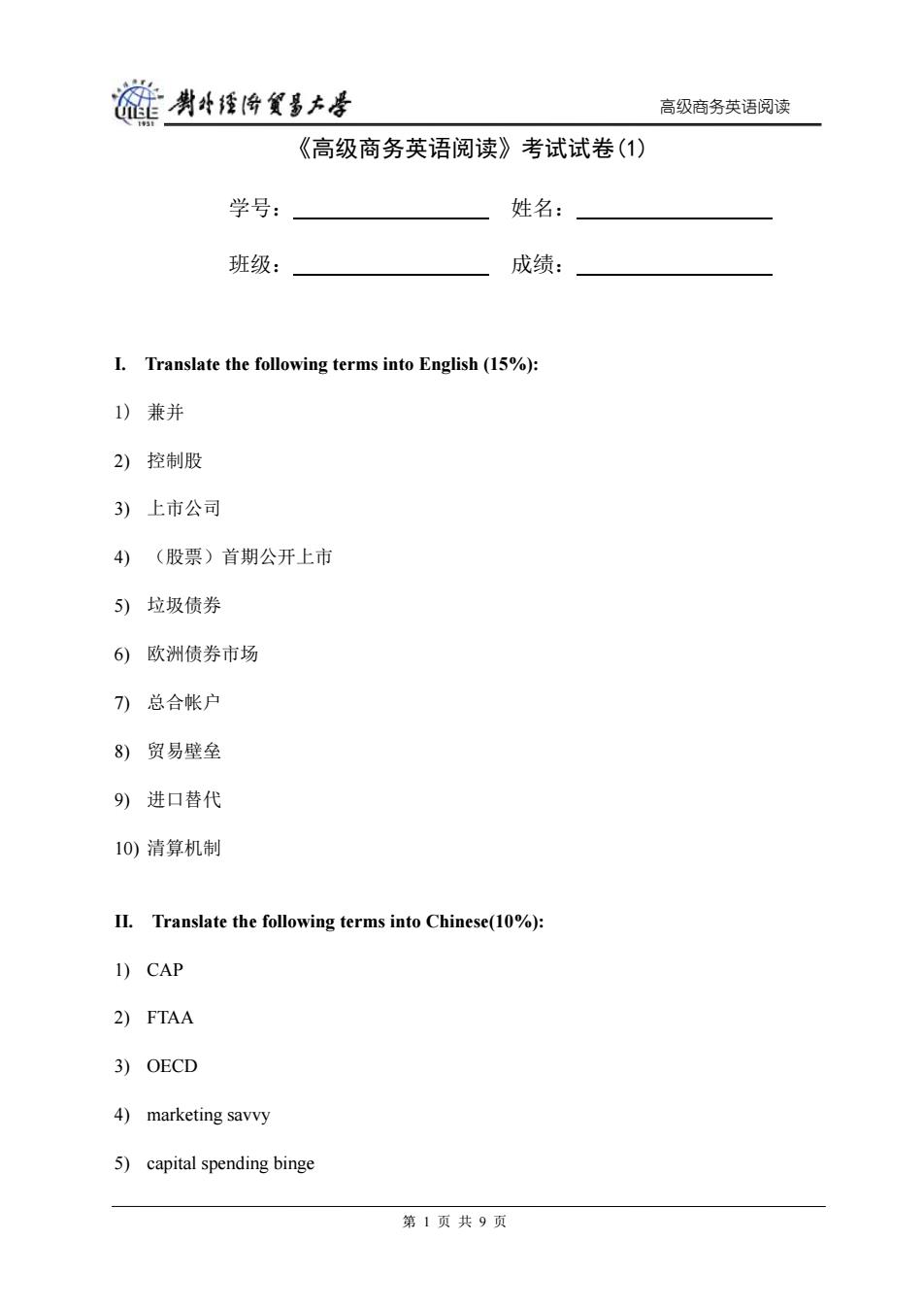
旋剥经降贸墨去号 高级商务英语阅读 《高级商务英语阅读》考试试卷(1) 学号: 姓名: 班级: 成绩: I.Translate the following terms into English(15%): 1)兼并 2)控制股 3)上市公司 4) (股票)首期公开上市 5) 垃圾债券 6)欧洲债券市场 7)总合帐户 8)贸易壁垒 9)进口替代 10)清算机制 II.Translate the following terms into Chinese(10%): 1)CAP 2) FTAA 3)OECD 4) marketing savvy 5) capital spending binge 第1页共9页
高级商务英语阅读 《高级商务英语阅读》考试试卷(1) 学号: 姓名: 班级: 成绩: I. Translate the following terms into English (15%): 1) 兼并 2) 控制股 3) 上市公司 4) (股票)首期公开上市 5) 垃圾债券 6) 欧洲债券市场 7) 总合帐户 8) 贸易壁垒 9) 进口替代 10) 清算机制 II. Translate the following terms into Chinese(10%): 1) CAP 2) FTAA 3) OECD 4) marketing savvy 5) capital spending binge 第 1 页 共 9 页
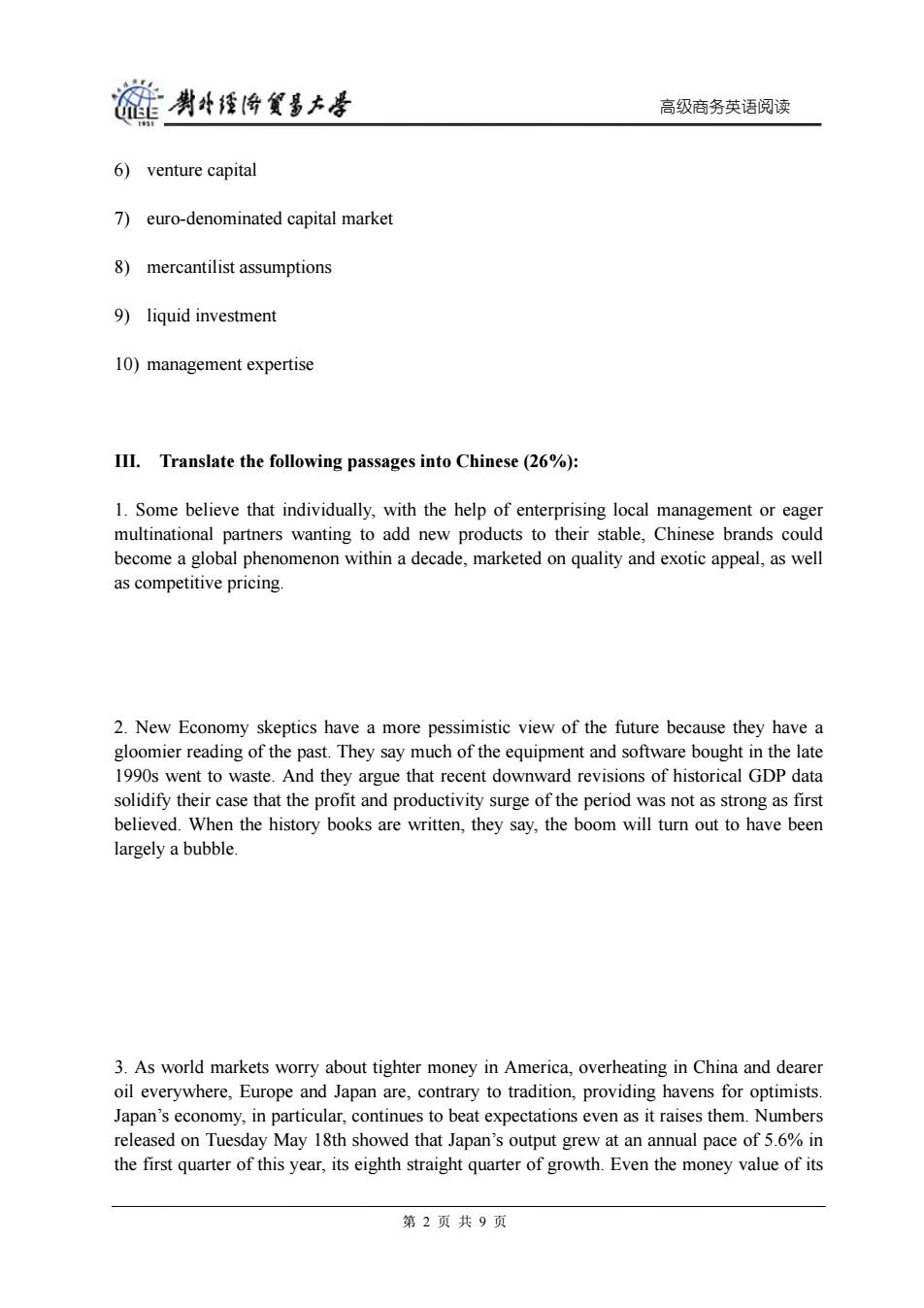
碰男华挂海贸多大学 高级商务英语阅读 6)venture capital 7)euro-denominated capital market 8)mercantilist assumptions 9)liquid investment 10)management expertise III.Translate the following passages into Chinese (26%): 1.Some believe that individually,with the help of enterprising local management or eager multinational partners wanting to add new products to their stable,Chinese brands could become a global phenomenon within a decade,marketed on quality and exotic appeal,as well as competitive pricing. 2.New Economy skeptics have a more pessimistic view of the future because they have a gloomier reading of the past.They say much of the equipment and software bought in the late 1990s went to waste.And they argue that recent downward revisions of historical GDP data solidify their case that the profit and productivity surge of the period was not as strong as first believed.When the history books are written,they say,the boom will turn out to have been largely a bubble. 3.As world markets worry about tighter money in America,overheating in China and dearer oil everywhere,Europe and Japan are,contrary to tradition,providing havens for optimists Japan's economy,in particular,continues to beat expectations even as it raises them.Numbers released on Tuesday May 18th showed that Japan's output grew at an annual pace of 5.6%in the first quarter of this year,its eighth straight quarter of growth.Even the money value of its 第2页共9页
高级商务英语阅读 6) venture capital 7) euro-denominated capital market 8) mercantilist assumptions 9) liquid investment 10) management expertise III. Translate the following passages into Chinese (26%): 1. Some believe that individually, with the help of enterprising local management or eager multinational partners wanting to add new products to their stable, Chinese brands could become a global phenomenon within a decade, marketed on quality and exotic appeal, as well as competitive pricing. 2. New Economy skeptics have a more pessimistic view of the future because they have a gloomier reading of the past. They say much of the equipment and software bought in the late 1990s went to waste. And they argue that recent downward revisions of historical GDP data solidify their case that the profit and productivity surge of the period was not as strong as first believed. When the history books are written, they say, the boom will turn out to have been largely a bubble. 3. As world markets worry about tighter money in America, overheating in China and dearer oil everywhere, Europe and Japan are, contrary to tradition, providing havens for optimists. Japan’s economy, in particular, continues to beat expectations even as it raises them. Numbers released on Tuesday May 18th showed that Japan’s output grew at an annual pace of 5.6% in the first quarter of this year, its eighth straight quarter of growth. Even the money value of its 第 2 页 共 9 页
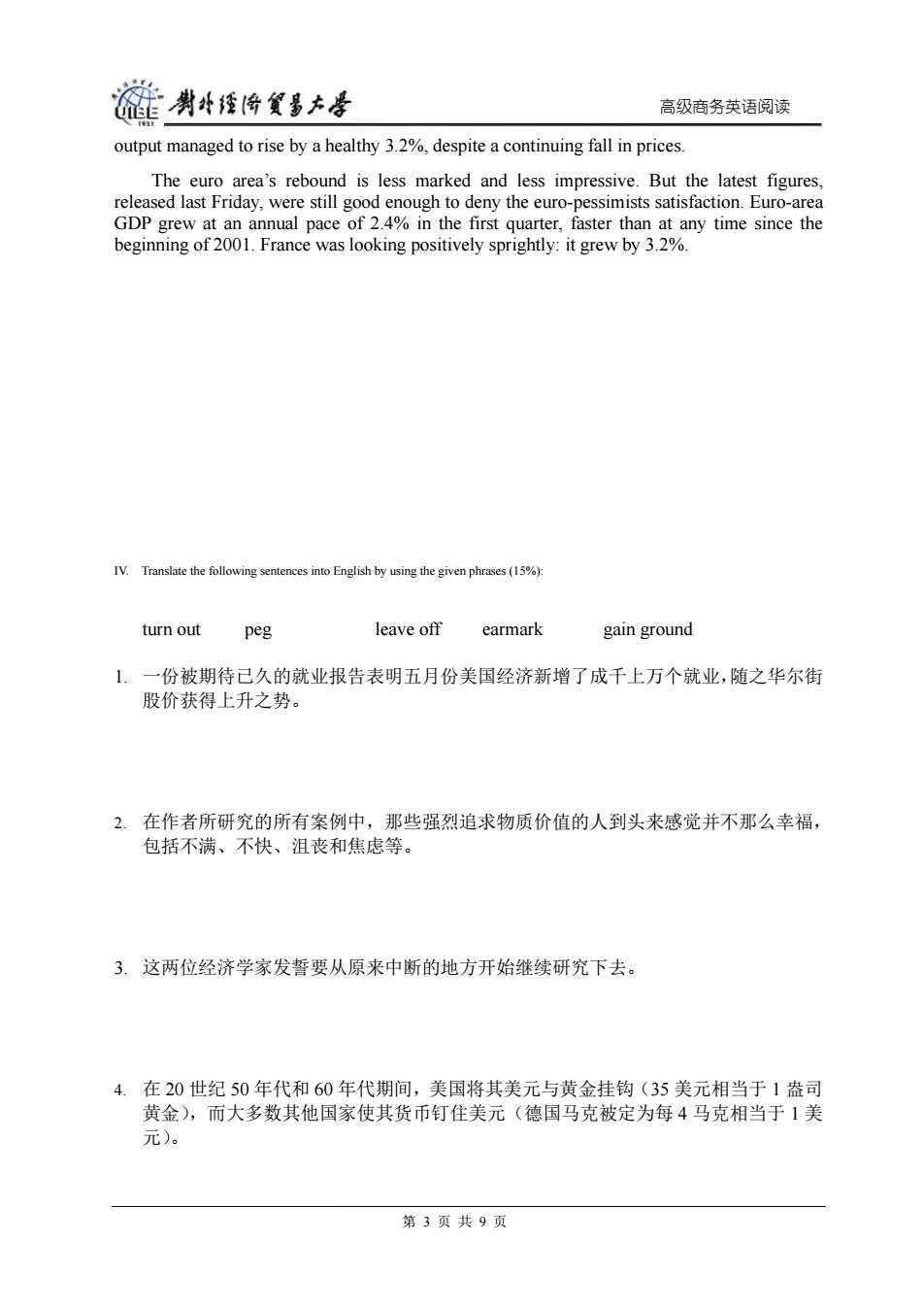
能男牛语降贸多大 高级商务英语阅读 output managed to rise by a healthy 3.2%,despite a continuing fall in prices. The euro area's rebound is less marked and less impressive.But the latest figures, released last Friday,were still good enough to deny the euro-pessimists satisfaction.Euro-area GDP grew at an annual pace of 2.4%in the first quarter,faster than at any time since the beginning of 2001.France was looking positively sprightly:it grew by 3.2%. IV.Translate the following sentences into English by using the given phrases(15%): turn out peg leave off earmark gain ground 1.一份被期待己久的就业报告表明五月份美国经济新增了成千上万个就业,随之华尔街 股价获得上升之势。 2.在作者所研究的所有案例中,那些强烈追求物质价值的人到头来感觉并不那么幸福, 包括不满、不快、沮丧和焦虑等。 3.这两位经济学家发誓要从原来中断的地方开始继续研究下去。 4.在20世纪50年代和60年代期间,美国将其美元与黄金挂钩(35美元相当于1盎司 黄金),而大多数其他国家使其货币钉住美元(德国马克被定为每4马克相当于1美 元)。 第3页共9页
高级商务英语阅读 output managed to rise by a healthy 3.2%, despite a continuing fall in prices. The euro area’s rebound is less marked and less impressive. But the latest figures, released last Friday, were still good enough to deny the euro-pessimists satisfaction. Euro-area GDP grew at an annual pace of 2.4% in the first quarter, faster than at any time since the beginning of 2001. France was looking positively sprightly: it grew by 3.2%. IV. Translate the following sentences into English by using the given phrases (15%): turn out peg leave off earmark gain ground 1. 一份被期待已久的就业报告表明五月份美国经济新增了成千上万个就业,随之华尔街 股价获得上升之势。 2. 在作者所研究的所有案例中,那些强烈追求物质价值的人到头来感觉并不那么幸福, 包括不满、不快、沮丧和焦虑等。 3. 这两位经济学家发誓要从原来中断的地方开始继续研究下去。 4. 在 20 世纪 50 年代和 60 年代期间,美国将其美元与黄金挂钩(35 美元相当于 1 盎司 黄金),而大多数其他国家使其货币钉住美元(德国马克被定为每 4 马克相当于 1 美 元)。 第 3 页 共 9 页
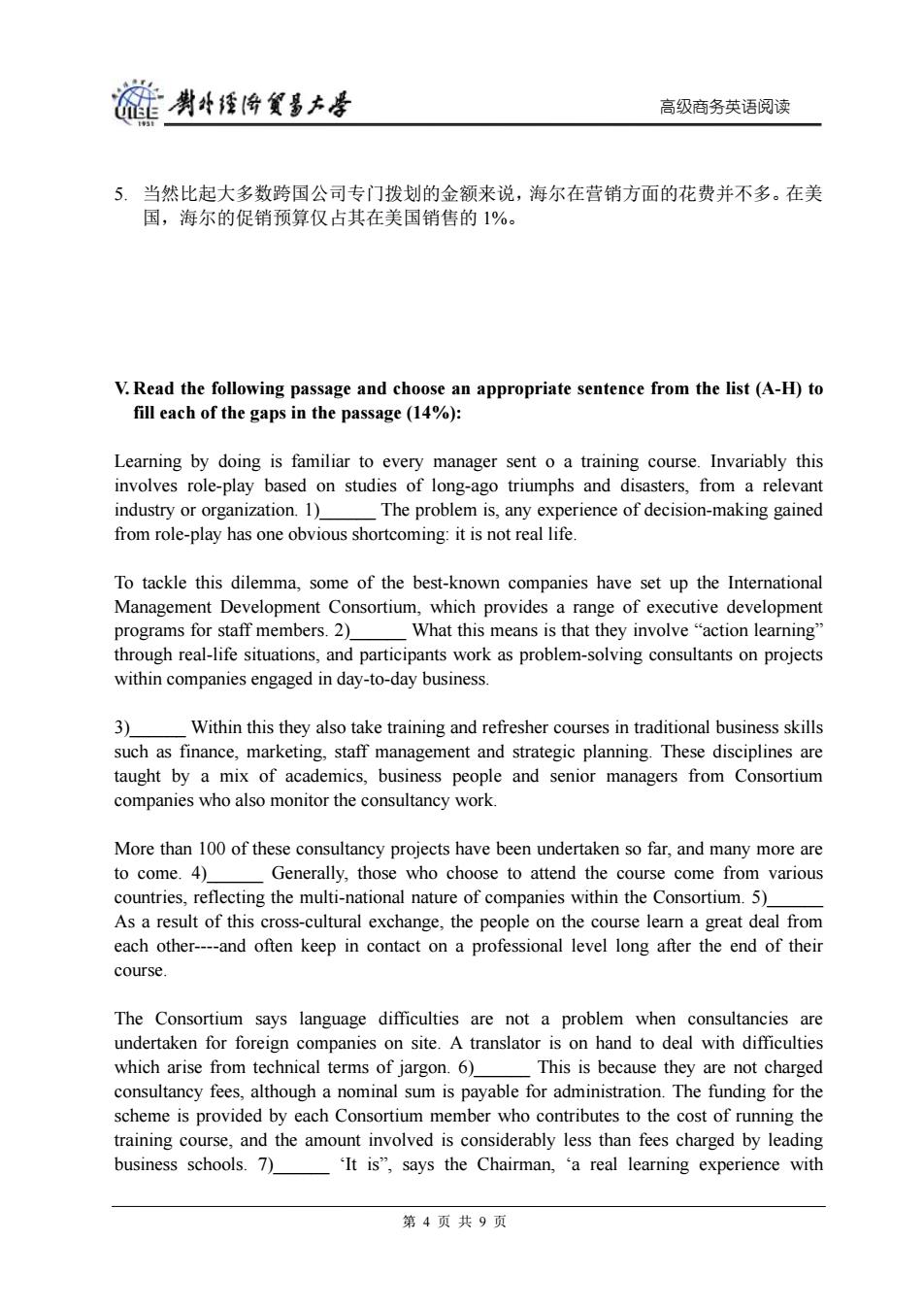
裢典外煙降餐多大岸 高级商务英语阅读 5.当然比起大多数跨国公司专门拨划的金额来说,海尔在营销方面的花费并不多。在美 国,海尔的促销预算仅占其在美国销售的1%。 V.Read the following passage and choose an appropriate sentence from the list(A-H)to fill each of the gaps in the passage (14%): Learning by doing is familiar to every manager sent o a training course.Invariably this involves role-play based on studies of long-ago triumphs and disasters,from a relevant industry or organization.1)The problem is,any experience of decision-making gained from role-play has one obvious shortcoming:it is not real life. To tackle this dilemma,some of the best-known companies have set up the International Management Development Consortium,which provides a range of executive development programs for staff members.2)What this means is that they involve "action learning" through real-life situations,and participants work as problem-solving consultants on projects within companies engaged in day-to-day business. 3) Within this they also take training and refresher courses in traditional business skills such as finance,marketing,staff management and strategic planning.These disciplines are taught by a mix of academics,business people and senior managers from Consortium companies who also monitor the consultancy work. More than 100 of these consultancy projects have been undertaken so far,and many more are to come.4)Generally,those who choose to attend the course come from various countries,reflecting the multi-national nature of companies within the Consortium.5) As a result of this cross-cultural exchange,the people on the course learn a great deal from each other----and often keep in contact on a professional level long after the end of their course. The Consortium says language difficulties are not a problem when consultancies are undertaken for foreign companies on site.A translator is on hand to deal with difficulties which arise from technical terms of jargon.6)This is because they are not charged consultancy fees,although a nominal sum is payable for administration.The funding for the scheme is provided by each Consortium member who contributes to the cost of running the training course,and the amount involved is considerably less than fees charged by leading business schools.7)It is",says the Chairman,'a real learning experience with 第4页共9页
高级商务英语阅读 5. 当然比起大多数跨国公司专门拨划的金额来说,海尔在营销方面的花费并不多。在美 国,海尔的促销预算仅占其在美国销售的 1%。 V. Read the following passage and choose an appropriate sentence from the list (A-H) to fill each of the gaps in the passage (14%): Learning by doing is familiar to every manager sent o a training course. Invariably this involves role-play based on studies of long-ago triumphs and disasters, from a relevant industry or organization. 1)______ The problem is, any experience of decision-making gained from role-play has one obvious shortcoming: it is not real life. To tackle this dilemma, some of the best-known companies have set up the International Management Development Consortium, which provides a range of executive development programs for staff members. 2)______ What this means is that they involve “action learning” through real-life situations, and participants work as problem-solving consultants on projects within companies engaged in day-to-day business. 3)______ Within this they also take training and refresher courses in traditional business skills such as finance, marketing, staff management and strategic planning. These disciplines are taught by a mix of academics, business people and senior managers from Consortium companies who also monitor the consultancy work. More than 100 of these consultancy projects have been undertaken so far, and many more are to come. 4)______ Generally, those who choose to attend the course come from various countries, reflecting the multi-national nature of companies within the Consortium. 5)______ As a result of this cross-cultural exchange, the people on the course learn a great deal from each other----and often keep in contact on a professional level long after the end of their course. The Consortium says language difficulties are not a problem when consultancies are undertaken for foreign companies on site. A translator is on hand to deal with difficulties which arise from technical terms of jargon. 6)______ This is because they are not charged consultancy fees, although a nominal sum is payable for administration. The funding for the scheme is provided by each Consortium member who contributes to the cost of running the training course, and the amount involved is considerably less than fees charged by leading business schools. 7)______ ‘It is”, says the Chairman, ‘a real learning experience with 第 4 页 共 9 页
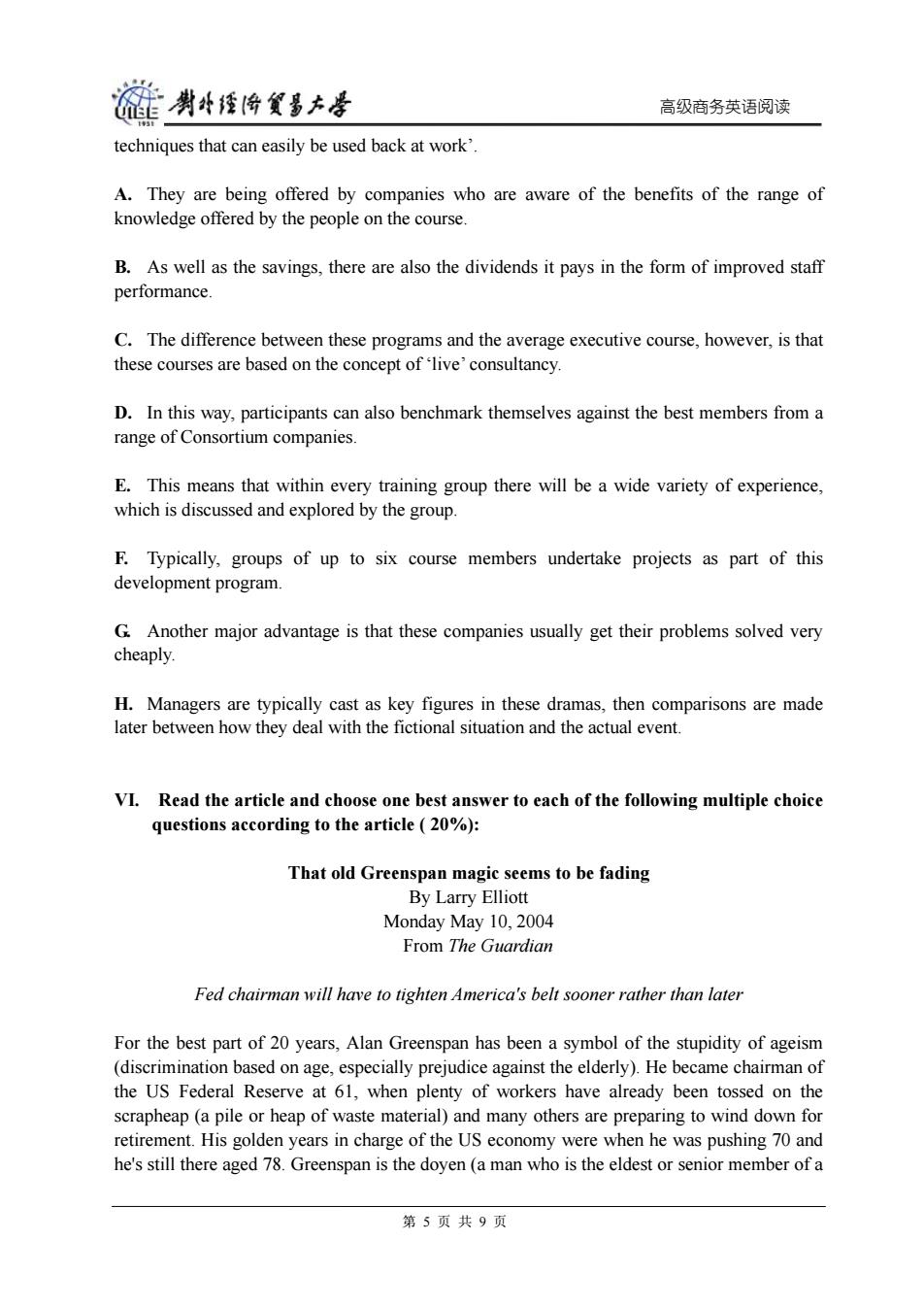
碰男华经海贸多大号 高级商务英语阅读 techniques that can easily be used back at work' A.They are being offered by companies who are aware of the benefits of the range of knowledge offered by the people on the course. B.As well as the savings,there are also the dividends it pays in the form of improved staff performance. C.The difference between these programs and the average executive course,however,is that these courses are based on the concept of 'live'consultancy. D.In this way,participants can also benchmark themselves against the best members from a range of Consortium companies. E.This means that within every training group there will be a wide variety of experience, which is discussed and explored by the group. F.Typically,groups of up to six course members undertake projects as part of this development program. G.Another major advantage is that these companies usually get their problems solved very cheaply. H.Managers are typically cast as key figures in these dramas,then comparisons are made later between how they deal with the fictional situation and the actual event. VI.Read the article and choose one best answer to each of the following multiple choice questions according to the article 20%): That old Greenspan magic seems to be fading By Larry Elliott Monday May 10,2004 From The Guardian Fed chairman will have to tighten America's belt sooner rather than later For the best part of 20 years,Alan Greenspan has been a symbol of the stupidity of ageism (discrimination based on age,especially prejudice against the elderly).He became chairman of the US Federal Reserve at 61,when plenty of workers have already been tossed on the scrapheap (a pile or heap of waste material)and many others are preparing to wind down for retirement.His golden years in charge of the US economy were when he was pushing 70 and he's still there aged 78.Greenspan is the doyen (a man who is the eldest or senior member of a 第5页共9页
高级商务英语阅读 techniques that can easily be used back at work’. A. They are being offered by companies who are aware of the benefits of the range of knowledge offered by the people on the course. B. As well as the savings, there are also the dividends it pays in the form of improved staff performance. C. The difference between these programs and the average executive course, however, is that these courses are based on the concept of ‘live’ consultancy. D. In this way, participants can also benchmark themselves against the best members from a range of Consortium companies. E. This means that within every training group there will be a wide variety of experience, which is discussed and explored by the group. F. Typically, groups of up to six course members undertake projects as part of this development program. G. Another major advantage is that these companies usually get their problems solved very cheaply. H. Managers are typically cast as key figures in these dramas, then comparisons are made later between how they deal with the fictional situation and the actual event. VI. Read the article and choose one best answer to each of the following multiple choice questions according to the article ( 20%): That old Greenspan magic seems to be fading By Larry Elliott Monday May 10, 2004 From The Guardian Fed chairman will have to tighten America's belt sooner rather than later For the best part of 20 years, Alan Greenspan has been a symbol of the stupidity of ageism (discrimination based on age, especially prejudice against the elderly). He became chairman of the US Federal Reserve at 61, when plenty of workers have already been tossed on the scrapheap (a pile or heap of waste material) and many others are preparing to wind down for retirement. His golden years in charge of the US economy were when he was pushing 70 and he's still there aged 78. Greenspan is the doyen (a man who is the eldest or senior member of a 第 5 页 共 9 页
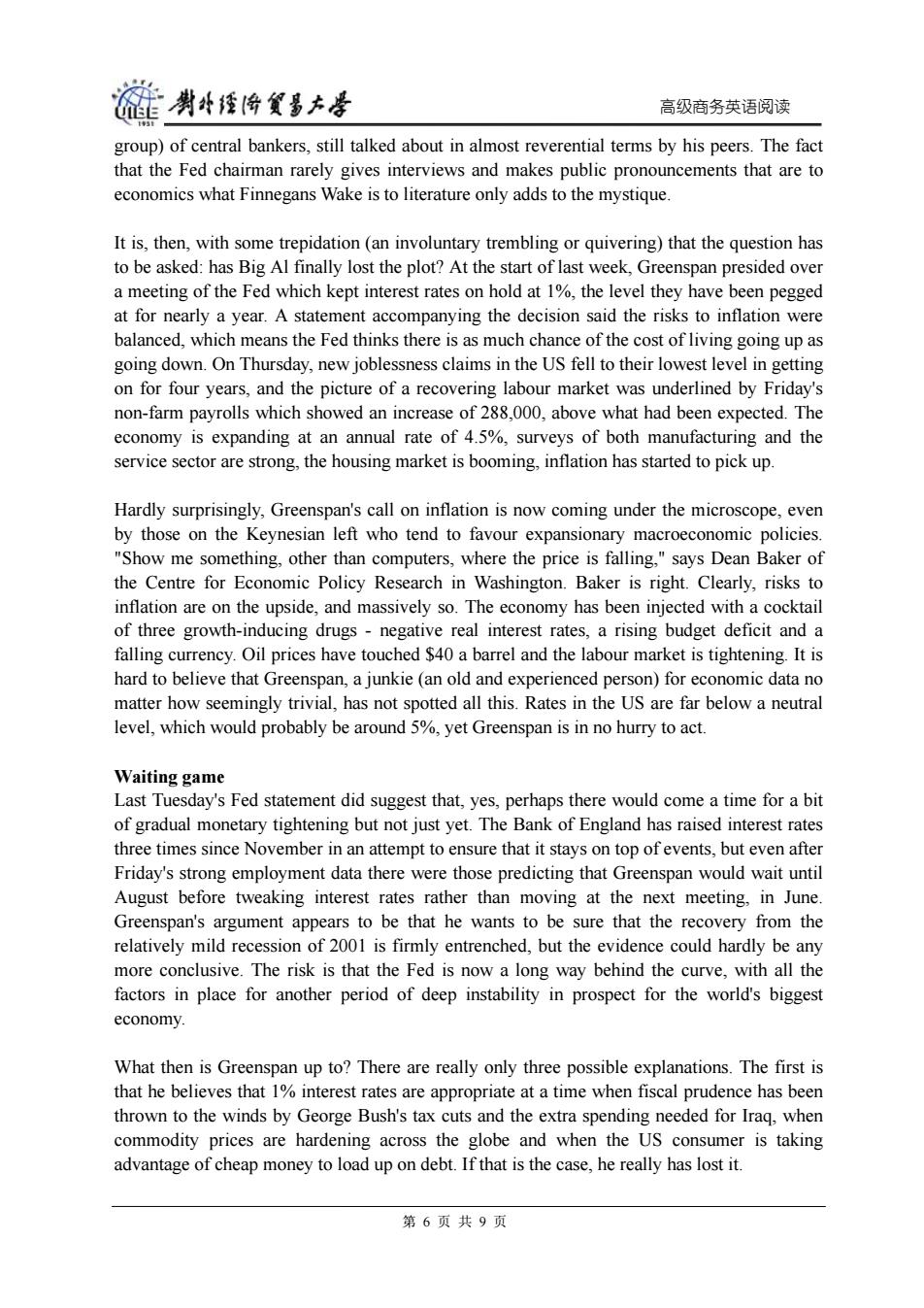
莲剥4将发多大号 高级商务英语阅读 group)of central bankers,still talked about in almost reverential terms by his peers.The fact that the Fed chairman rarely gives interviews and makes public pronouncements that are to economics what Finnegans Wake is to literature only adds to the mystique. It is,then,with some trepidation (an involuntary trembling or quivering)that the question has to be asked:has Big Al finally lost the plot?At the start of last week,Greenspan presided over a meeting of the Fed which kept interest rates on hold at 1%,the level they have been pegged at for nearly a year.A statement accompanying the decision said the risks to inflation were balanced,which means the Fed thinks there is as much chance of the cost of living going up as going down.On Thursday,new joblessness claims in the US fell to their lowest level in getting on for four years,and the picture of a recovering labour market was underlined by Friday's non-farm payrolls which showed an increase of 288,000,above what had been expected.The economy is expanding at an annual rate of 4.5%,surveys of both manufacturing and the service sector are strong,the housing market is booming,inflation has started to pick up. Hardly surprisingly,Greenspan's call on inflation is now coming under the microscope,even by those on the Keynesian left who tend to favour expansionary macroeconomic policies. "Show me something,other than computers,where the price is falling,"says Dean Baker of the Centre for Economic Policy Research in Washington.Baker is right.Clearly,risks to inflation are on the upside,and massively so.The economy has been injected with a cocktail of three growth-inducing drugs-negative real interest rates,a rising budget deficit and a falling currency.Oil prices have touched $40 a barrel and the labour market is tightening.It is hard to believe that Greenspan,a junkie (an old and experienced person)for economic data no matter how seemingly trivial,has not spotted all this.Rates in the US are far below a neutral level,which would probably be around 5%,yet Greenspan is in no hurry to act. Waiting game Last Tuesday's Fed statement did suggest that,yes,perhaps there would come a time for a bit of gradual monetary tightening but not just yet.The Bank of England has raised interest rates three times since November in an attempt to ensure that it stays on top of events,but even after Friday's strong employment data there were those predicting that Greenspan would wait until August before tweaking interest rates rather than moving at the next meeting,in June. Greenspan's argument appears to be that he wants to be sure that the recovery from the relatively mild recession of 2001 is firmly entrenched,but the evidence could hardly be any more conclusive.The risk is that the Fed is now a long way behind the curve,with all the factors in place for another period of deep instability in prospect for the world's biggest economy. What then is Greenspan up to?There are really only three possible explanations.The first is that he believes that 1%interest rates are appropriate at a time when fiscal prudence has been thrown to the winds by George Bush's tax cuts and the extra spending needed for Iraq,when commodity prices are hardening across the globe and when the US consumer is taking advantage of cheap money to load up on debt.If that is the case,he really has lost it. 第6页共9页
高级商务英语阅读 group) of central bankers, still talked about in almost reverential terms by his peers. The fact that the Fed chairman rarely gives interviews and makes public pronouncements that are to economics what Finnegans Wake is to literature only adds to the mystique. It is, then, with some trepidation (an involuntary trembling or quivering) that the question has to be asked: has Big Al finally lost the plot? At the start of last week, Greenspan presided over a meeting of the Fed which kept interest rates on hold at 1%, the level they have been pegged at for nearly a year. A statement accompanying the decision said the risks to inflation were balanced, which means the Fed thinks there is as much chance of the cost of living going up as going down. On Thursday, new joblessness claims in the US fell to their lowest level in getting on for four years, and the picture of a recovering labour market was underlined by Friday's non-farm payrolls which showed an increase of 288,000, above what had been expected. The economy is expanding at an annual rate of 4.5%, surveys of both manufacturing and the service sector are strong, the housing market is booming, inflation has started to pick up. Hardly surprisingly, Greenspan's call on inflation is now coming under the microscope, even by those on the Keynesian left who tend to favour expansionary macroeconomic policies. "Show me something, other than computers, where the price is falling," says Dean Baker of the Centre for Economic Policy Research in Washington. Baker is right. Clearly, risks to inflation are on the upside, and massively so. The economy has been injected with a cocktail of three growth-inducing drugs - negative real interest rates, a rising budget deficit and a falling currency. Oil prices have touched $40 a barrel and the labour market is tightening. It is hard to believe that Greenspan, a junkie (an old and experienced person) for economic data no matter how seemingly trivial, has not spotted all this. Rates in the US are far below a neutral level, which would probably be around 5%, yet Greenspan is in no hurry to act. Waiting game Last Tuesday's Fed statement did suggest that, yes, perhaps there would come a time for a bit of gradual monetary tightening but not just yet. The Bank of England has raised interest rates three times since November in an attempt to ensure that it stays on top of events, but even after Friday's strong employment data there were those predicting that Greenspan would wait until August before tweaking interest rates rather than moving at the next meeting, in June. Greenspan's argument appears to be that he wants to be sure that the recovery from the relatively mild recession of 2001 is firmly entrenched, but the evidence could hardly be any more conclusive. The risk is that the Fed is now a long way behind the curve, with all the factors in place for another period of deep instability in prospect for the world's biggest economy. What then is Greenspan up to? There are really only three possible explanations. The first is that he believes that 1% interest rates are appropriate at a time when fiscal prudence has been thrown to the winds by George Bush's tax cuts and the extra spending needed for Iraq, when commodity prices are hardening across the globe and when the US consumer is taking advantage of cheap money to load up on debt. If that is the case, he really has lost it. 第 6 页 共 9 页

肖外径份氨多本是 高级商务英语阅读 The second explanation is that Greenspan believes the US economic recovery is much less robust than the public has been led to believe,and that withdrawing monetary stimulus could bring the house of cards down.This is not a message much heard in the US (where the predominant voice is that of Wall Street economists who have a vested interest is talking up the stock market)but it is true that Greenspan solved the problems caused by the collapse of the bubble in the stock market by creating two new bubbles-in the housing and bond markets Economist Kurt Richebacher puts it this way:"The stock market bubble of the 1920s ended with an unprecedented consumption boom,and just that has been happening again since 1997, and in particular since 2001.Since then,consumer spending has accounted for 92%of GDP growth.Yet,to keep it rising in the face of grossly lacking income growth,the Fed has invented a policy stance that has no precedent in history:boosting home prices with artificially low interest rates in order to provide rapidly growing collateral for consumer borrowing." Richebacher's view is that Greenspan has papered over the "existing maladjustments from the boom through even bigger,new bubbles and macroeconomic maladjustments,heralding much worse to come in the future". What next? The key question is what happens once policymakers try to wean the US off its growth drugs. Unless Bush is prepared to push through new tax cuts-the ultimate dud cheque,given the size of the budget deficit-the boost to consumers from higher take-home pay will fade.Raising interest rates would pull the rug from under the housing market,while if the Fed's negligent approach allows inflation to pick up over the coming months watch out for a crash in the bond market.Even the tiniest threat of higher short-term rates spooked Wall Street last week:it's not hard to imagine what some aggressive tightening would do,particularly if it looked as though the Fed was struggling to catch up. All that said,there is still enough momentum in the US economy to carry it along into next year,by which time the presidential election will be over.This is the third possible explanation for Greenspan's actions;that having been seen as a contributory factor in the downfall of one member of the Bush family,he is making sure he doesn't fluff his lines second time around.If this is the case,it doesn't say much for the independence of the Fed,and it will add to the economic problems of whoever wins in November.It's a good bet that there will be a large dollop of both monetary and fiscal belt-tightening in 2005,and Greenspan might be well advised to bow out gracefully before the brown stuff attaches itself to the fan.As Gordon Brown always says,there are only two types of finance minister:those who fail and those who get out in time.The same applies to central bankers 1.For the best part of 20 years,Alan Greenspan A.has been regarded as a stupid man. B.has been the doyen of central bankers C.has demonstrated his ability in spite of old age. 第7页共9页
高级商务英语阅读 The second explanation is that Greenspan believes the US economic recovery is much less robust than the public has been led to believe, and that withdrawing monetary stimulus could bring the house of cards down. This is not a message much heard in the US (where the predominant voice is that of Wall Street economists who have a vested interest is talking up the stock market) but it is true that Greenspan solved the problems caused by the collapse of the bubble in the stock market by creating two new bubbles - in the housing and bond markets. Economist Kurt Richebächer puts it this way: "The stock market bubble of the 1920s ended with an unprecedented consumption boom, and just that has been happening again since 1997, and in particular since 2001. Since then, consumer spending has accounted for 92% of GDP growth. Yet, to keep it rising in the face of grossly lacking income growth, the Fed has invented a policy stance that has no precedent in history: boosting home prices with artificially low interest rates in order to provide rapidly growing collateral for consumer borrowing." Richebächer's view is that Greenspan has papered over the "existing maladjustments from the boom through even bigger, new bubbles and macroeconomic maladjustments, heralding much worse to come in the future". What next? The key question is what happens once policymakers try to wean the US off its growth drugs. Unless Bush is prepared to push through new tax cuts - the ultimate dud cheque, given the size of the budget deficit - the boost to consumers from higher take-home pay will fade. Raising interest rates would pull the rug from under the housing market, while if the Fed's negligent approach allows inflation to pick up over the coming months watch out for a crash in the bond market. Even the tiniest threat of higher short-term rates spooked Wall Street last week: it's not hard to imagine what some aggressive tightening would do, particularly if it looked as though the Fed was struggling to catch up. All that said, there is still enough momentum in the US economy to carry it along into next year, by which time the presidential election will be over. This is the third possible explanation for Greenspan's actions; that having been seen as a contributory factor in the downfall of one member of the Bush family, he is making sure he doesn't fluff his lines second time around. If this is the case, it doesn't say much for the independence of the Fed, and it will add to the economic problems of whoever wins in November. It's a good bet that there will be a large dollop of both monetary and fiscal belt-tightening in 2005, and Greenspan might be well advised to bow out gracefully before the brown stuff attaches itself to the fan. As Gordon Brown always says, there are only two types of finance minister: those who fail and those who get out in time. The same applies to central bankers. 1. For the best part of 20 years, Alan Greenspan ________ A. has been regarded as a stupid man. B. has been the doyen of central bankers. C. has demonstrated his ability in spite of old age. 第 7 页 共 9 页
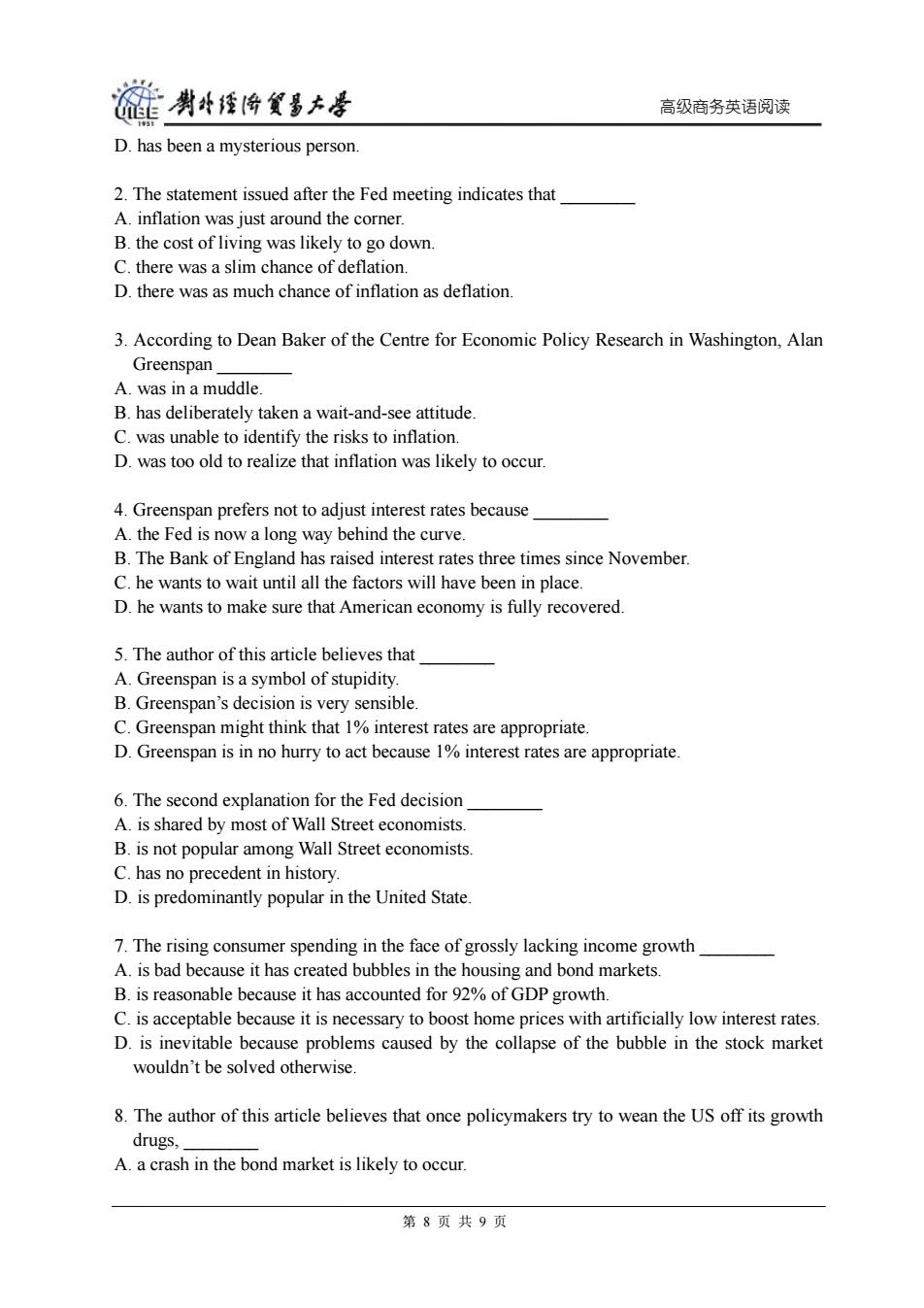
碰男华经海贸多大号 高级商务英语阅读 D.has been a mysterious person. 2.The statement issued after the Fed meeting indicates that A.inflation was just around the corner. B.the cost of living was likely to go down. C.there was a slim chance of deflation. D.there was as much chance of inflation as deflation. 3.According to Dean Baker of the Centre for Economic Policy Research in Washington,Alan Greenspan A.was in a muddle. B.has deliberately taken a wait-and-see attitude C.was unable to identify the risks to inflation. D.was too old to realize that inflation was likely to occur. 4.Greenspan prefers not to adjust interest rates because A.the Fed is now a long way behind the curve. B.The Bank of England has raised interest rates three times since November. C.he wants to wait until all the factors will have been in place. D.he wants to make sure that American economy is fully recovered. 5.The author of this article believes that A.Greenspan is a symbol of stupidity. B.Greenspan's decision is very sensible. C.Greenspan might think that 1%interest rates are appropriate. D.Greenspan is in no hurry to act because 1%interest rates are appropriate. 6.The second explanation for the Fed decision A.is shared by most of Wall Street economists. B.is not popular among Wall Street economists. C.has no precedent in history. D.is predominantly popular in the United State. 7.The rising consumer spending in the face of grossly lacking income growth A.is bad because it has created bubbles in the housing and bond markets. B.is reasonable because it has accounted for 92%of GDP growth. C.is acceptable because it is necessary to boost home prices with artificially low interest rates. D.is inevitable because problems caused by the collapse of the bubble in the stock market wouldn't be solved otherwise. 8.The author of this article believes that once policymakers try to wean the US off its growth drugs, A.a crash in the bond market is likely to occur. 第8页共9页
高级商务英语阅读 D. has been a mysterious person. 2. The statement issued after the Fed meeting indicates that ________ A. inflation was just around the corner. B. the cost of living was likely to go down. C. there was a slim chance of deflation. D. there was as much chance of inflation as deflation. 3. According to Dean Baker of the Centre for Economic Policy Research in Washington, Alan Greenspan ________ A. was in a muddle. B. has deliberately taken a wait-and-see attitude. C. was unable to identify the risks to inflation. D. was too old to realize that inflation was likely to occur. 4. Greenspan prefers not to adjust interest rates because ________ A. the Fed is now a long way behind the curve. B. The Bank of England has raised interest rates three times since November. C. he wants to wait until all the factors will have been in place. D. he wants to make sure that American economy is fully recovered. 5. The author of this article believes that ________ A. Greenspan is a symbol of stupidity. B. Greenspan’s decision is very sensible. C. Greenspan might think that 1% interest rates are appropriate. D. Greenspan is in no hurry to act because 1% interest rates are appropriate. 6. The second explanation for the Fed decision ________ A. is shared by most of Wall Street economists. B. is not popular among Wall Street economists. C. has no precedent in history. D. is predominantly popular in the United State. 7. The rising consumer spending in the face of grossly lacking income growth ________ A. is bad because it has created bubbles in the housing and bond markets. B. is reasonable because it has accounted for 92% of GDP growth. C. is acceptable because it is necessary to boost home prices with artificially low interest rates. D. is inevitable because problems caused by the collapse of the bubble in the stock market wouldn’t be solved otherwise. 8. The author of this article believes that once policymakers try to wean the US off its growth drugs, ________ A. a crash in the bond market is likely to occur. 第 8 页 共 9 页

碰剥经悔贸昌大号 高级商务英语阅读 B.the Bush Administration has to push through new tax cuts. C.the Bush Administration has to raise interest rates. D.some aggressive tightening becomes essential. 9.The third possible explanation for Greenspan's actions is that A.he wants to make sure that he won't let Bush down in the presidential election. B.he has contributed to the downfall of one member of the Bush family. C.he wants to get out in time gracefully. D.monetary and fiscal belt-tightening is a must in 2005 10.Of all the three possible explanations,the third one seems to true because A.Greenspan has been a symbol of the stupidity of ageism. B.Greenspan is absolutely sure that he is about to step down. C.Greenspan's actions seem to be politically motivated. D.Greenspan doesn't want to fail,and he wants to get out in time. 第9页共9页
高级商务英语阅读 B. the Bush Administration has to push through new tax cuts. C. the Bush Administration has to raise interest rates. D. some aggressive tightening becomes essential. 9. The third possible explanation for Greenspan's actions is that ________ A. he wants to make sure that he won’t let Bush down in the presidential election. B. he has contributed to the downfall of one member of the Bush family. C. he wants to get out in time gracefully. D. monetary and fiscal belt-tightening is a must in 2005. 10. Of all the three possible explanations, the third one seems to true because ________ A. Greenspan has been a symbol of the stupidity of ageism. B. Greenspan is absolutely sure that he is about to step down. C. Greenspan's actions seem to be politically motivated. D. Greenspan doesn’t want to fail, and he wants to get out in time. 第 9 页 共 9 页